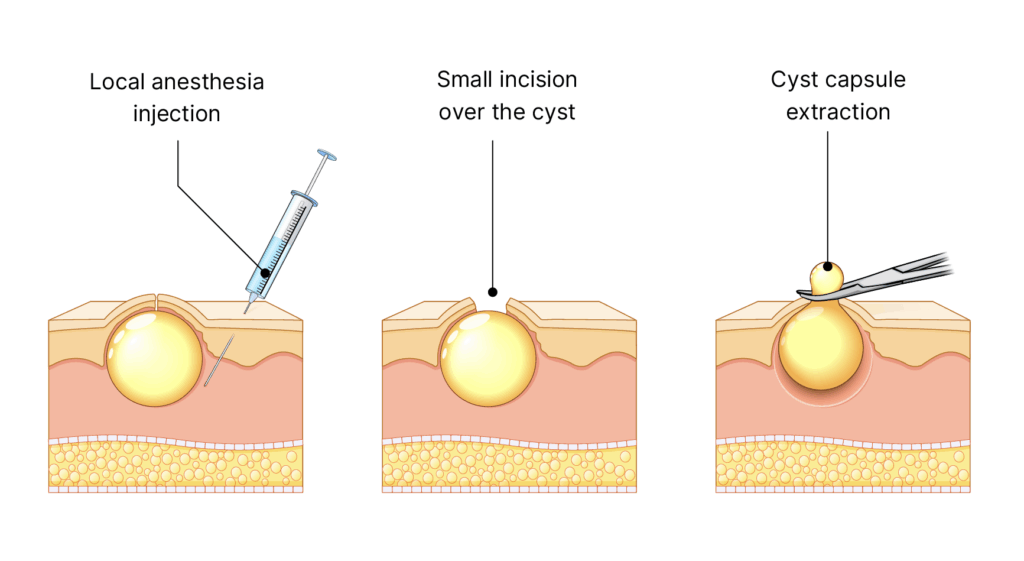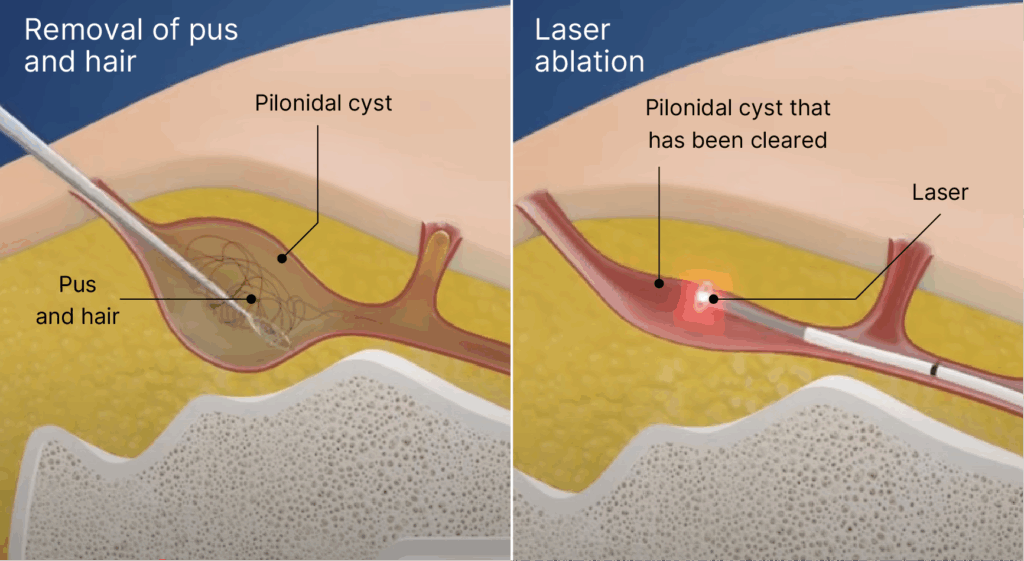Tailbone Abscess Removal Surgery
What Is Tailbone Abscess Removal Surgery and Why Is It Needed?
Tailbone abscess removal surgery or perianal abscess surgery is a procedure used to remove pilonidal abscesses, which are infected cysts that appear near the tailbone. This abscess removal is often suggested for patients who have recurrent flare-ups of the condition. It may also be used if non-surgical options have failed or complications have arisen.
This abscess surgery is a relatively common treatment for people with pilonidal abscesses. The aim is to open and clear the infected cavity while removing sinus tracts, eliminating thesource of infection. The actual approach will depend on the patient’s symptom severity, risk of complications, and history of the condition.
Learn more about pilonidal cysts.
Incision and Drainage (I&D)
The incision and drainage or I&D method is performed under local anaesthesia and does not remove the entire cyst or sinus tract. It involves making a small cut to release pus, so it has a higher chance of abscess recurrence. However, this procedure can be a first-line intervention for relief.

Traditional Excision Surgery
This abscess treatment surgically removes the pilonidal cyst and affected tissue around it. The wound may be left open (slower healing, lower recurrence risk) or closed (faster healing, higher recurrence risk) after the surgery. Your doctor will select a recommended option based on your circumstances and needs.
Off-Midline Flap Surgery (Gluteal Cleft-Lift Procedure)
This is used for recurrent or complex pilonidal disease as it removes the cyst and nearby affected tissue while also using a flap of healthy skin and tissue to cover the wound.

Minimally Invasive Treatments
These treatments are generally advised only for select cases of mild pilonidal disease or patients who want to avoid larger incisions. More invasive treatment or pilonidal abscess surgery is still the usual approach for substantial or recurrent disease.
- Pit Picking (Gips procedure): This uses a tiny incision to remove the small skin openings (“pits”) and any superficial sinus tracts.
- Endoscopic Ablation (EPSiT/VAAPS): This uses an endoscope or video scope to visualise the sinus tract from the inside. After that, the doctor can remove hair and inflamed tissue, then cauterise the tract lining from within.
- Phenol Injections: These are injected into the sinus tract after drainage. The procedure works to sterilise and sclerose (harden) the tract, and shrink or eliminate smaller sinuses.
- Laser Hair Removal: This is not a treatment for an active abscess, but to prevent pilonidal cysts from recurring.
When to Consider Tailbone Abscess Removal
Patients should generally consider pilonidal cyst surgery if the condition has impacted their quality of life. If a person has recurrent or persistent cysts, severe pain, swelling, bleeding, or chronic discomfort from sitting, it may be time to consider seeking medical treatment.
Doctors will typically assess your condition and whether or not conservative treatments may be effective in addressing it. Early intervention is typically associated with better outcomes, as it helps avoid further complications. As such, people are advised to see a doctor about pilonidal sinus surgery as soon as they begin to see symptoms.
See a Specialist on Tailbone Abscess Removal
Schedule a consultation with our specialist for an assessment and to see if this is the best course of action for you.
What to Expect with Tailbone Abscess Removal
Before the Surgery
During the pre-operation consultation, our specialist will examine you to diagnose your condition and go over the recommended treatment. This will include explanations of the procedure, goals, risks, and prep and aftercare instructions.
You are encouraged to ask questions or raise concerns at this point. Our team will not only address all of your queries but also guide you through what to do before and after the procedure.
During the Surgery
Tailbone abscess removal surgery takes about an hour, and is typically an outpatient procedure. It may be done under general or local anaesthesia and the precise approach depends on the case.
These are the main steps:
- Creating an incision over the abscess
- Draining and cleaning out all pus and debris
- Excising or cutting out the cyst wall and any branching sinus tracts
- Leaving the surgical site open or closing it through stitches or flaps
After the Surgery
Most patients will be able to go home on the same day as their tailbone abscess removal surgery. Some may be required to stay a day or two longer, but this is just for more complex cases. Your doctor and care team will provide you with information on what to expect and key aftercare instructions.
Contact your doctor if you see these symptoms during the recovery period, as they may indicate a complication:
- Any sudden, large volume of bloody drainage
- Blood soaking through bandages rapidly
- Chills
- Fever
- Persistent dizziness, nausea, or vomiting
- Severe pain or swelling
Recovery and Prognosis for Piles Surgery
As this is generally an outpatient procedure, you should be able to head home on the same day as the surgery. You can return to light activities like desk work in 1 to 2 weeks, but it is advised to avoid heavy lifting or activities for around 4 weeks.
These are some common aftercare steps you may be advised to follow:
- Change your wound dressing daily if your procedure involved an open wound.
- Avoid submerging the wound in water (e.g. baths or pools) if your incision was closed with stitches.
- Take sitz baths as recommended, especially in the first 1 to 2 days post-surgery, to help with hygiene and pain relief.
- Maintain good hygiene and consider regular hair removal to reduce recurrence risk.
Most patients experience lasting relief once the abscess has been treated and the area has healed. It is advised to sustain habits that minimise recurrence risk afterwards, such as hair removal and maintaining good hygiene.
Risk and Side Effects of Piles Surgery
Tailbone abscess removal is a common procedure for treating pilonidal disease. However, it has its risks and possible side effects, like all procedures:
- Abscess recurrence, although it is simply a long-term risk of the condition itself
- Bleeding, usually light and temporary after surgery
- Hematoma or collection of blood under the skin
- Infection after surgery, the risk of which can be brought down with antibiotics
- Post-operative pain
- Infection after surgery as a risk of all procedures > a course of antibiotics will be provided after surgery to reduce risk of this
In rare cases, seroma or clear fluid buildup, which is treatable
Surgery Fees and Insurance Coverage
For a detailed fee breakdown or to check your eligibility for insurance or Medisave claims, please get in touch with us.
Discuss Your Treatment Options with a Specialist
If you’ve been diagnosed with haemorrhoids or are experiencing ongoing discomfort, speak with our specialist to find out if surgery is right for you.
